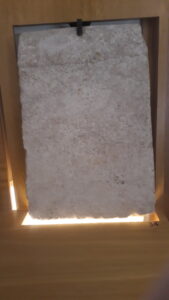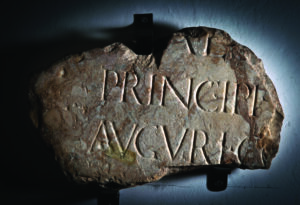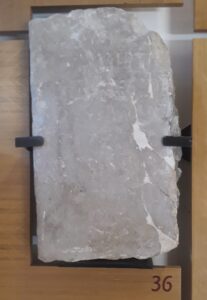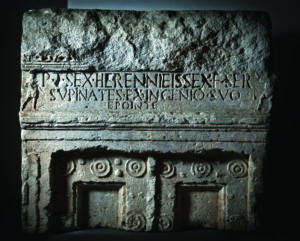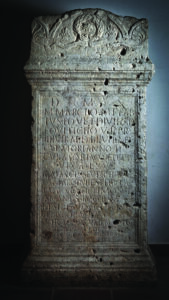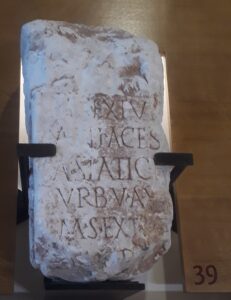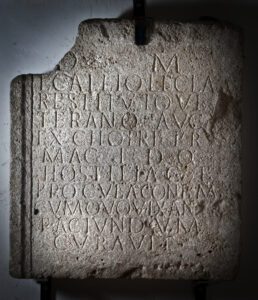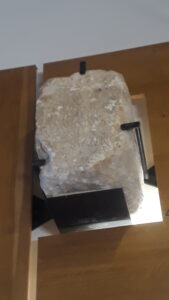STATE AND MUNICIPAL INSTITUTIONS
Some inscriptions on display also open glimpses on the ‘grande’history’.
The base of a statue of Silla (no. 34), erected in Alba Fucens in the years of his dictatorship (82-79 BC) confirms the strong bond between the city and the victorious general with allocation in Albanian territory of veterans of his lieutenant Metello Pio.
On the other hand, the relationship between the Fucino region and the Roman state that can be found in other inscriptions: in the onomastic formula of the characters mentioned, also remember the tribe or registry office (once also electoral) into which they were enrolled or the main municipal offices.
38 – Limestone funerary altar with arched top. II century. A.D. (Cerreto – Avezzano).
D(is) M(anibus) s(acrum).
M(arco) Marcio M(arci) f(ilio) Fab(ia tribu)
Iusto, vet(erano) Divi Had(riani),
equiti c(o)ho(rtis) VII pr(aetoriae),
IIIIvir(o) aed(ili), IIIIvir(o) i(ure) d(icundo),
curatori anno(nae) (iterum)
curatori aquaeductus,
vix(it) a(nnos) LXV,
M(arcus) Marcius Eutyches
et Marcia Restituta
patrono optimo, suis
amantissimo, b(ene) m(erenti)
et sibi suisque posteris
eorum.
Huic monumento
terra cedit
in fr(onte) p(edes) XXXV, in ag(ro) p(edes) LX
39 – Limestone funerary altar, on the left side sword with cingulum.
M(arco) Sextul[eio M(arci)? f(ilio)]
Ani(ensi tribu) Aces[ti? b(ene)f(iciario) Val(erii)]
Asiatici [v(iri) c(larissimi), praef(ecti)]
urb(i), vix(it) a(nnos) X[XX- – -]
M(arcus) Sext[uleius M(arci) l(ibertus)?]
[Sat]ur[ninus? b(ene) m(erenti) p(osuit)]
40 – Tabula in mutilated limestone at the top left.
D(is) M(anibus).
L(ucio) Callio L(ucii) f(ilio) Cla(udia tribu)
Restituto veterano
Aug(usti)
ex c(o)ho(rte) pri(ma) pr(aetoria),
mag(istro) i(ure) d(icundo), q(uaestori),
Hostilia C(ai) f(ilia)
Procula con(iugi) b(ene) m(erenti)
cum quo vix(it) an(nos) X[- – -]
faciundum curavit
